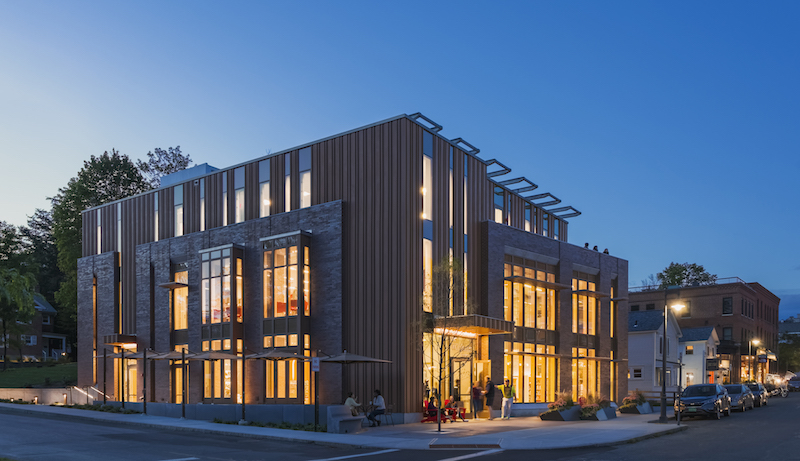The new Williams College campus bookstore includes everything you’d expect in a college bookstore plus a coffee shop, a dedicated area that can be sanctioned off for events and special talks, indoor/outdoor leisure spaces for the community, and a sustainable design that earned LEED Platinum designation.
The CambridgeSeven-designed building used local materials such as granite and bricks for the building’s exterior. A glazing to wall ratio of 24%, insulated glass with integral wood louvers, and an exterior brise soleil for enhanced thermal protection help the building achieve an Energy Use Intensity (EUI) rating of 39. The thicker than average, tightly sealed, insulated walls also help the bookstore achieve the EUI that is 41% better than baseline.
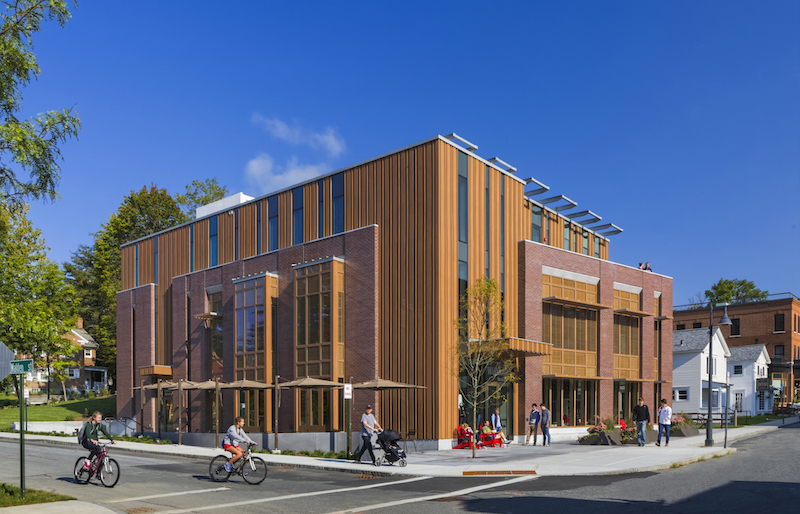 Courtesy Williams College.
Courtesy Williams College.
A stormwater management system helps keep stormwater runoff equal to the pre-development levels. This system includes a rain garden, deep sump catch basins, and underground detention to capture stormwater from roofs and new paving before it runs off the site.
See Also: Best in library design 2018: Six projects earn AIA/ALA library awards
The building does not use any gas, only electricity. As such, the PV array on the roof was designed to form a dynamic part of the building’s presence on Spring Street.
Other features include birch plywood ceilings and fabric paneled hidden doors to section off the café space for programming. In addition to the building design, CambridgeSeven also designed the building’s furniture and finishes.
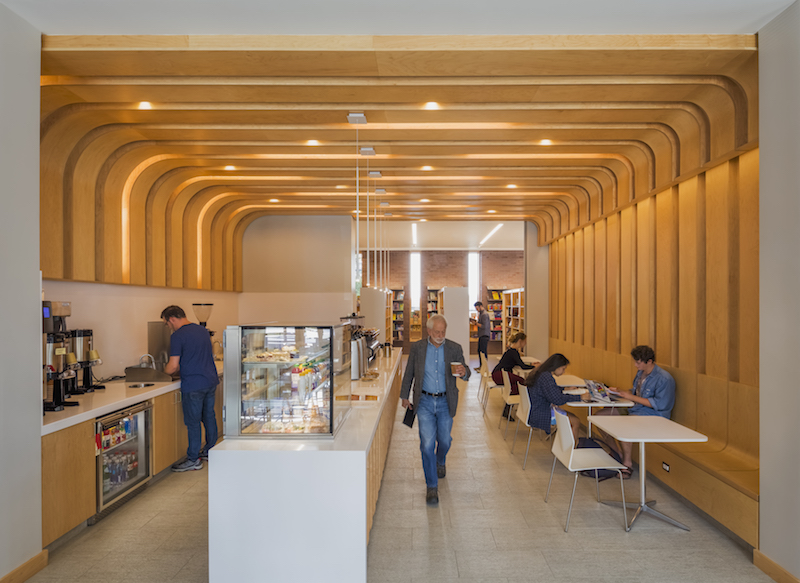 Courtesy Williams College.
Courtesy Williams College.
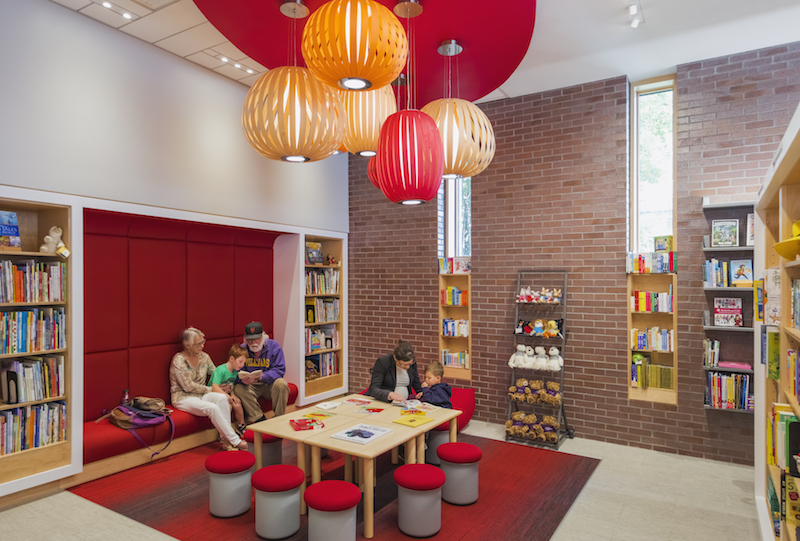 Courtesy Williams College.
Courtesy Williams College.
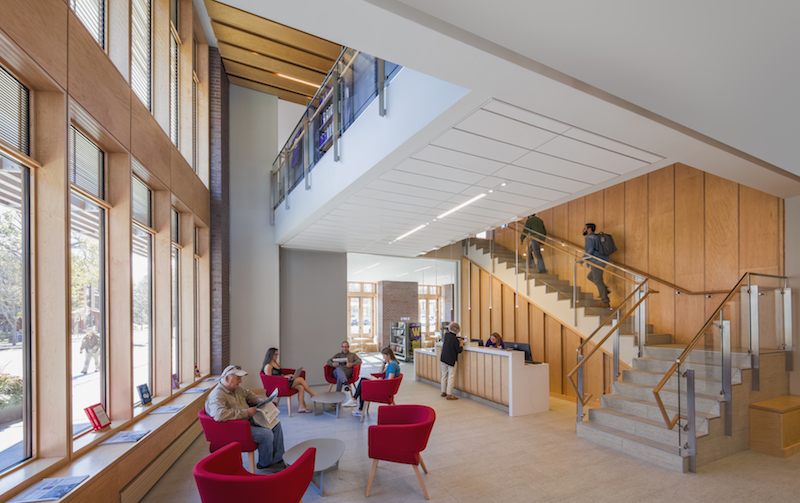 Courtesy Williams College.
Courtesy Williams College.
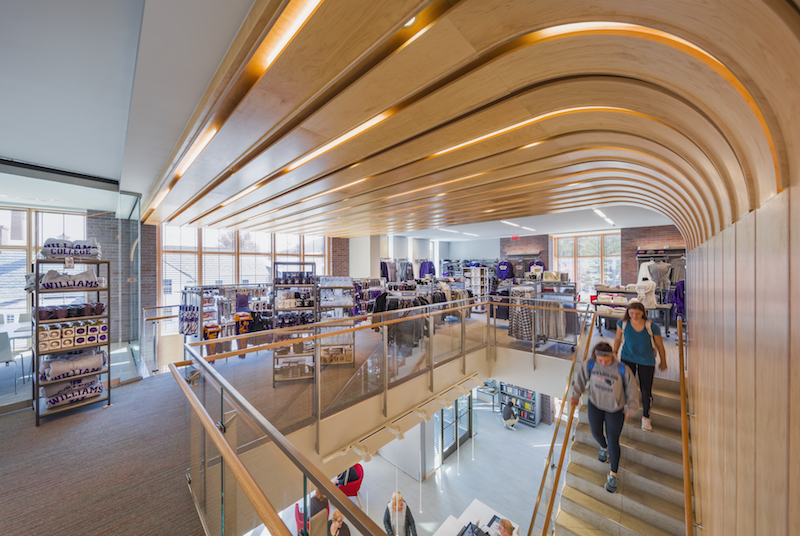 Courtesy Williams College.
Courtesy Williams College.
 Courtesy Williams College.
Courtesy Williams College.
 Courtesy Williams College.
Courtesy Williams College.
Related Stories
| Nov 9, 2010
Designing a library? Don’t focus on books
How do you design a library when print books are no longer its core business? Turn them into massive study halls. That’s what designers did at the University of Amsterdam, where they transformed the existing 27,000-sf library into a study center—without any visible books. About 2,000 students visit the facility daily and encounter workspaces instead of stacks.
| Nov 3, 2010
First of three green labs opens at Iowa State University
Designed by ZGF Architects, in association with OPN Architects, the Biorenewable Research Laboratory on the Ames campus of Iowa State University is the first of three projects completed as part of the school’s Biorenewables Complex. The 71,800-sf LEED Gold project is one of three wings that will make up the 210,000-sf complex.
| Nov 3, 2010
Seattle University’s expanded library trying for LEED Gold
Pfeiffer Partners Architects, in collaboration with Mithun Architects, programmed, planned, and designed the $55 million renovation and expansion of Lemieux Library and McGoldrick Learning Commons at Seattle University. The LEED-Gold-designed facility’s green features include daylighting, sustainable and recycled materials, and a rain garden.
| Nov 3, 2010
Recreation center targets student health, earns LEED Platinum
Not only is the student recreation center at the University of Arizona, Tucson, the hub of student life but its new 54,000-sf addition is also super-green, having recently attained LEED Platinum certification.
| Nov 3, 2010
Virginia biofuel research center moving along
The Sustainable Energy Technology Center has broken ground in October on the Danville, Va., campus of the Institute for Advanced Learning and Research. The 25,000-sf facility will be used to develop enhanced bio-based fuels, and will house research laboratories, support labs, graduate student research space, and faculty offices. Rainwater harvesting, a vegetated roof, low-VOC and recycled materials, photovoltaic panels, high-efficiency plumbing fixtures and water-saving systems, and LED light fixtures will be deployed. Dewberry served as lead architect, with Lord Aeck & Sargent serving as laboratory designer and sustainability consultant. Perigon Engineering consulted on high-bay process labs. New Atlantic Contracting is building the facility.
| Nov 3, 2010
Dining center cooks up LEED Platinum rating
Students at Bowling Green State University in Ohio will be eating in a new LEED Platinum multiuse dining center next fall. The 30,000-sf McDonald Dining Center will have a 700-seat main dining room, a quick-service restaurant, retail space, and multiple areas for students to gather inside and out, including a fire pit and several patios—one of them on the rooftop.
| Nov 1, 2010
John Pearce: First thing I tell designers: Do your homework!
John Pearce, FAIA, University Architect at Duke University, Durham, N.C., tells BD+C’s Robert Cassidy about the school’s construction plans and sustainability efforts, how to land work at Duke, and why he’s proceeding with caution when it comes to BIM.
| Oct 13, 2010
Editorial
The AEC industry shares a widespread obsession with the new. New is fresh. New is youthful. New is cool. But “old” or “slightly used” can be financially profitable and professionally rewarding, too.
| Oct 13, 2010
Campus building gives students a taste of the business world
William R. Hough Hall is the new home of the Warrington College of Business Administration at the University of Florida in Gainesville. The $17.6 million, 70,000-sf building gives students access to the latest technology, including a lab that simulates the stock exchange.
| Oct 13, 2010
Science building supports enrollment increases
The new Kluge-Moses Science Building at Piedmont Virginia Community College, in Charlottesville, is part of a campus update designed and managed by the Lukmire Partnership. The 34,000-sf building is designed to be both a focal point of the college and a recruitment mechanism to get more students enrolling in healthcare programs.


